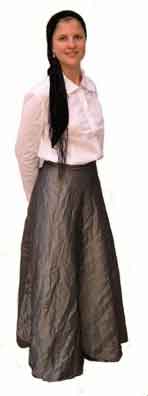By Talia Hava Davis
When I decided to dress only in long skirts and long sleeve shirts, my mom whined. "Talia! But you look so cute in pants!" But I had made up my mind. I told her I would wear pants at home with the family but only skirts when I was in public. It was a bid to recapture a sense of modesty that I had lost through my many years of secular education and flashing television images of naked women. I was searching for my place in the world and part of my path was going to take me deep into the heart of Orthodox Judaism. And let me tell you, it is quite a refresher to dress for yourself and not for the men or women in your life. I didn't worry about looking hot or stripping down my outfit to the bare bones so I could show off what Hashem made. I realized that what I had under my clothes was for me (and my future husband).
My personal path through Judaism, while never complete, took me through living a tznius lifestyle and I came out the other end with a newfound appreciation. Though I don't always wear skirts any more, I try, with my clothing and actions, to be modest. I found my spot. I know that when I get married, covering my hair will be important to me, and my future husband will need to share that value for Jewish law requires a man to dress modestly too. It's not so obvious today, mainly because women's clothing has gotten skimpier and skimpier while men's clothing has just gotten less formal. But it has always bothered me that people assume modesty is a woman's burden.
The Hebrew word tznius or tzniut means modesty. It is generally used in reference to women and also relates to humility and general conduct, especially between men and women. In Orthodox Judaism, modesty is a complicated and extensive topic. The following is a simple guide to some of the basic principles, but I invite you to explore it further.
(For the record, though I use the term "Ultra-Orthodox" to describe the Frum, or observant Jews who are differentiated from the Orthodox or Modern Orthodox, I do not intend it pejoratively. It serves here merely to differentiate the traditions for the uninitiated reader.)
Women's Dress
 From the outset, we must remember that there are different levels based on observance or sect, and that each group has its own minhag hamakom or tradition of the community. Some groups avoid most colors and dress in a black-and-brown palatte, some only avoid red, some deliberately don't follow fashion, and some are very fashionable.
From the outset, we must remember that there are different levels based on observance or sect, and that each group has its own minhag hamakom or tradition of the community. Some groups avoid most colors and dress in a black-and-brown palatte, some only avoid red, some deliberately don't follow fashion, and some are very fashionable.
Reform and Conservative Judaism put little to no emphasis modesty or tzniut. Conservative Judaism recommends modest dress, but it is not broadly observed on a daily basis and generally not discussed.
Orthodox Judaism has varying levels of modest dress. Modern Orthodox women generally wear shirts that reach the elbow and cover the collarbone, skirts that at least cover their knees, and may or may not wear stockings or tights. They may also wear pants in their own home. Some women may not ever go barefoot, preferring rather to wear socks to cover their feet if they aren't wearing shoes.
In Charedi or Ultra-Orthodox communities (which include many Chassidic Jews), the basic guidelines are as follows: shirts with sleeves that reach below the elbows (at least) and completely cover the collarbone, and skirts that cover the knees completely (even when sitting). They won't wear skirts with slits and often times will sew them shut or create a kick-pleat. Most groups prefer closed-toe shoes and stockings. Many communities have customs about the thickness of the stockings. Women will not go barefoot and if they aren't wearing shoes, will wear socks over their stockings.
As with any group, extremists exist. Some women in these insular sects are fully covered from their neck to the ground in clothing. They will wear loose-fitting shirts to their wrists and buttoned an inch or two above the collarbone. Their skirts are full and flowing, not form fitting, and reach the ground. They wear thick black or brown tights (beige would be immodest), and when they are married they shave their heads and cover them with scarves.
Head Covering
According to the Talmud, married women must cover their hair. The law is Talmud Ketubot 72a, Shulchan Aruch, Orach Chaim, 75:2 and based on the Bamidbar (Numbers) 5:18. The verse in Bamidbar refers to a married woman, who should not "advertise" herself to other men. A woman's hair is a sensuous feature and Orthodoxy teaches that it should only be enjoyed by the husband.
Many Modern Orthodox women only cover their hair in synagogue or will wear only a hat or scarf that still allows the natural hair to peek out.





